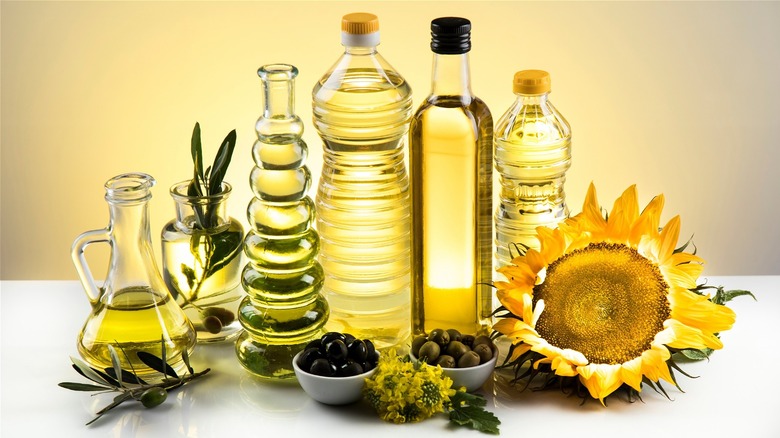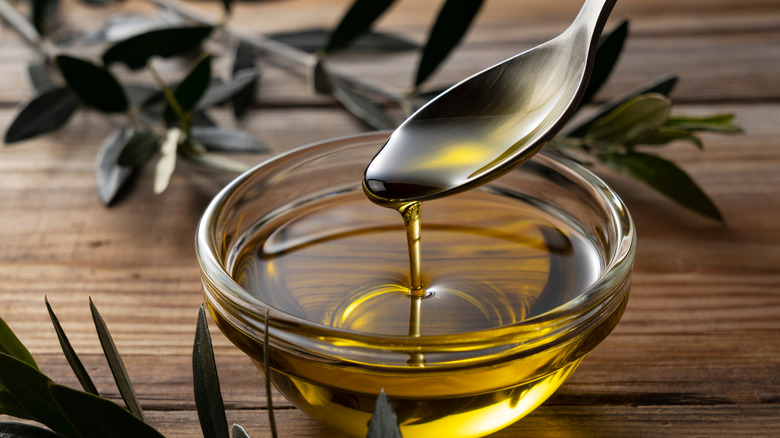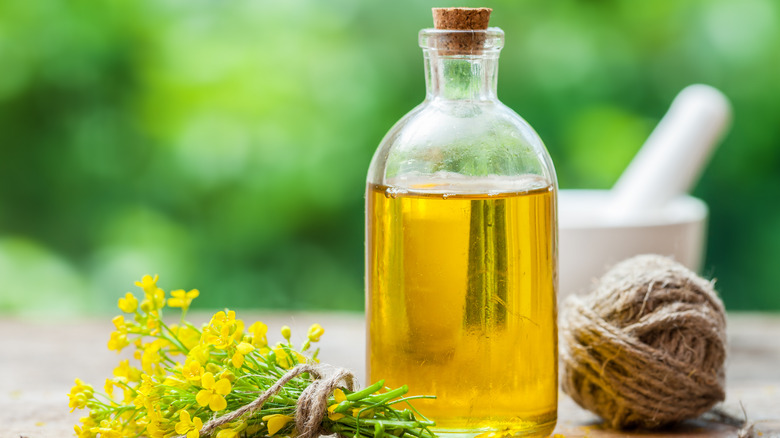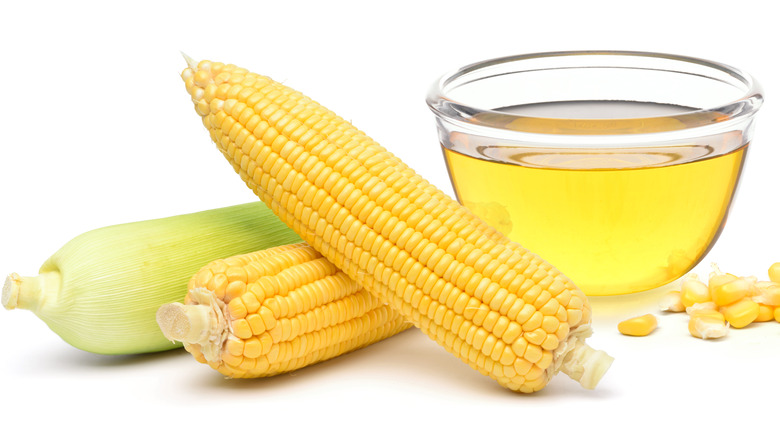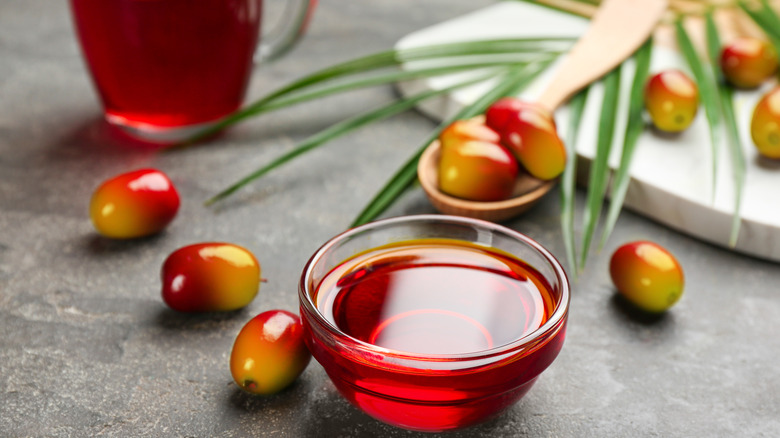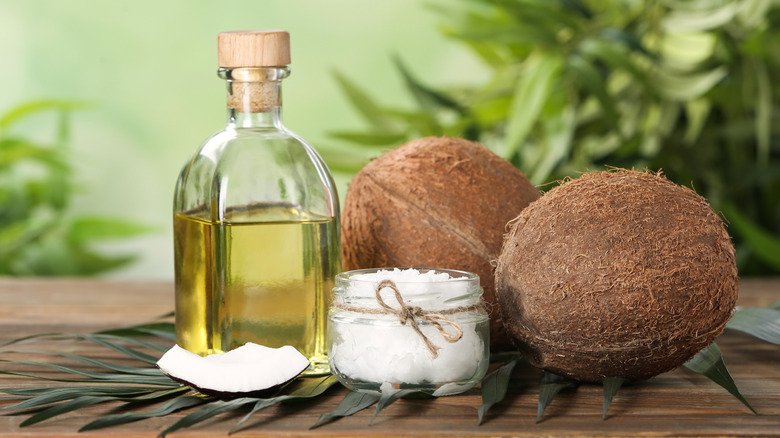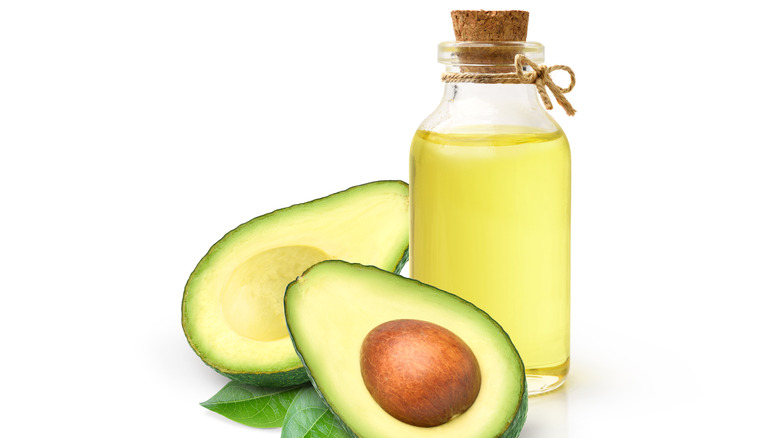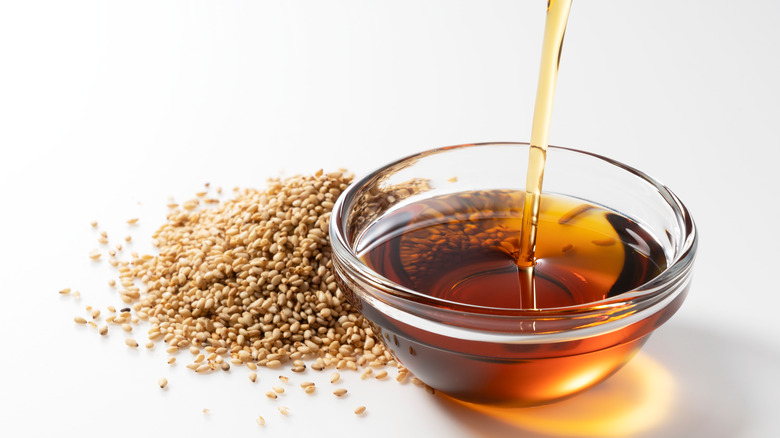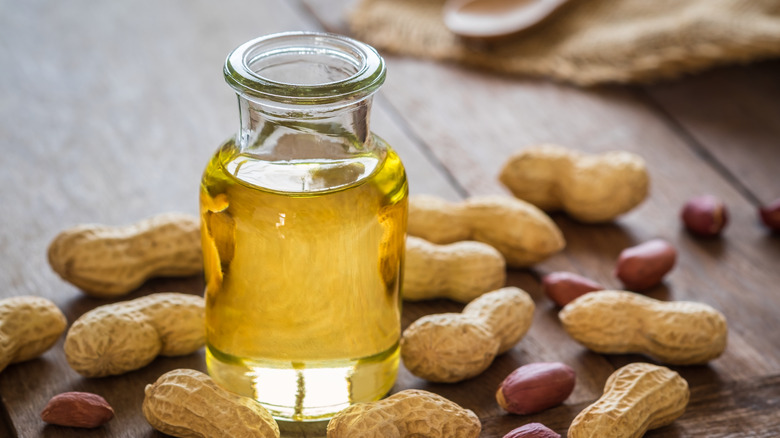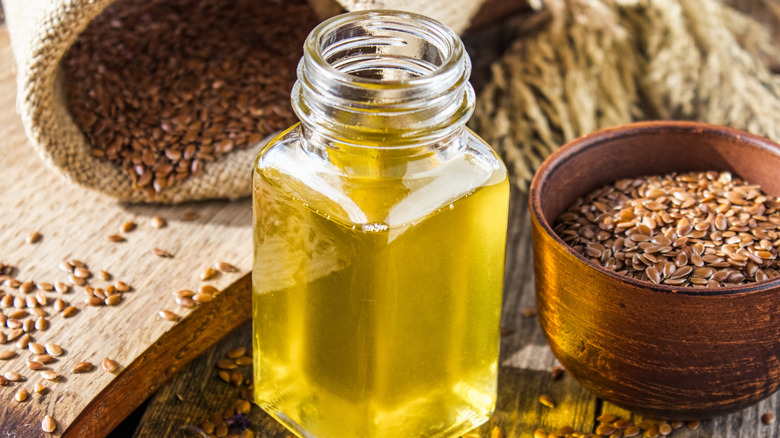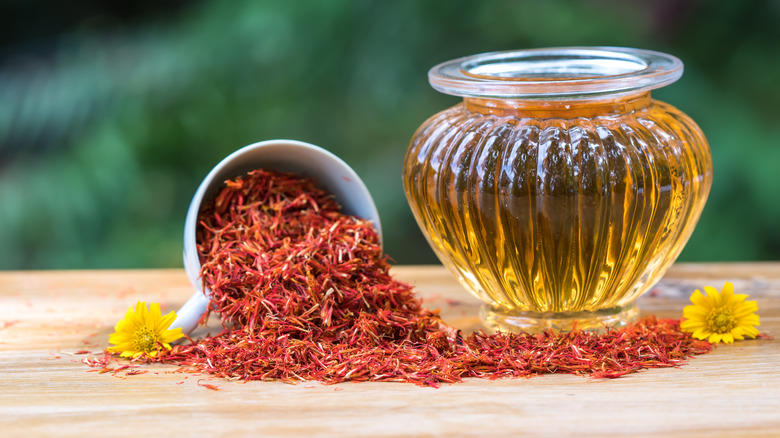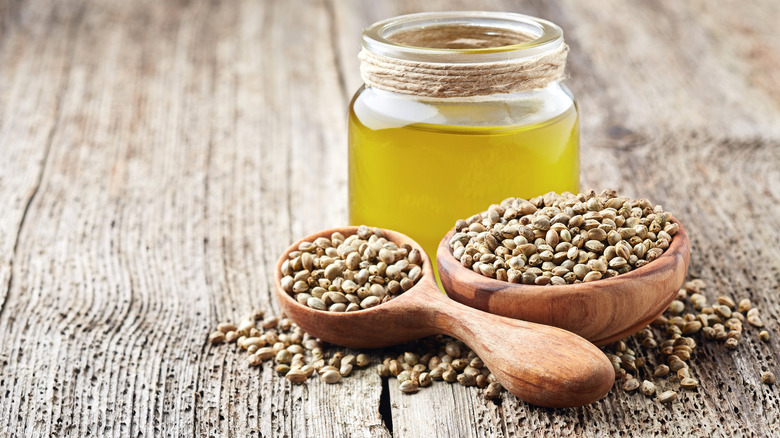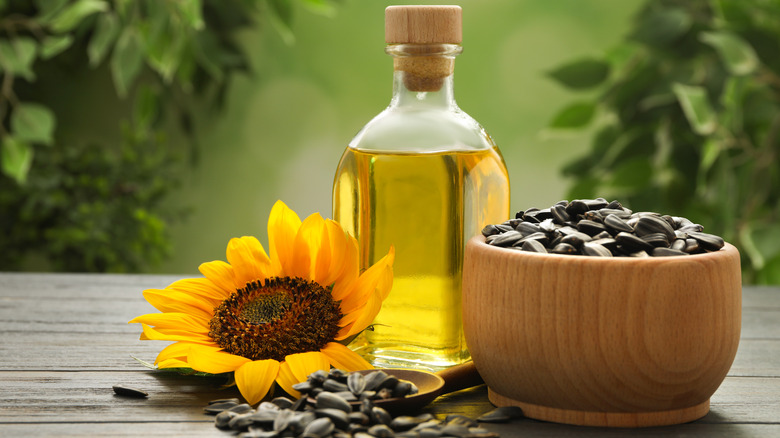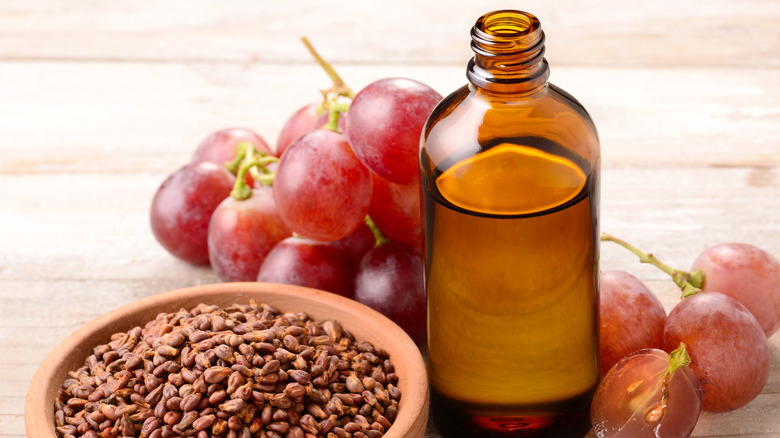14 Types Of Cooking Oil And How To Use Them
At the grocery store, there are so many cooking oils to choose from it can be overwhelming. Decision fatigue can cause you to stick with familiar favorites. But there is so much more than olive oil out there. Choosing the right oil for the job can even improve your cooking.
While cooking with oil isn't always necessary, you usually need a fat source when frying, roasting, and grilling. Oil helps conduct heat while preventing food from sticking to whatever you're cooking it on (via Home Cook World). Although cooking oils contain high amounts of fat, some of these fats are healthy — various oils give you different nutrients, as well.
Oil is usually made from seeds, fruits, or vegetables. Different processes are used to extract different oils from olives, corn kernels, coconut meat, sunflower seeds, or whatever it may be. Some of these processes, such as cold-pressing, are considered healthier than the process of hexane extraction. However, sometimes people also prefer a lack of processing, and seek out unrefined oils. Then there's the whole "extra-virgin olive oil" term to wrap your head around. Let's get started on our journey of understanding cooking oil. Here are 14 types of cooking oil and how to use them.
Olive oil
To make olive oil, we start with the olive tree. Olive trees produce the olives, which are eventually cleaned, crushed, and put through various steps to extract olive oil (via Colavita). Depending on which type of olive oil you have — extra virgin, virgin, pure, or pomace — the processes which it's put through can vary (via The Olive Tap). Extra virgin olive oil is considered the highest quality type. To achieve this marker of quality, olive oil must be produced using only machinery (no chemicals), and contain a final acid content of less than 0.8% acidity (via Olivado). This quality marker is recognized internationally. According to Olive Oil and Beyond, the International Olive Oil Council even has support from the United Nations to protect quality standards.
Olive oil has been used for more than 6,000 years, for culinary and other applications (via Brightland). Today, it's an excellent cooking tool due to its health benefits and complex flavor. Look for high quality, extra virgin olive oil, but also look for the terms robust, medium, or delicate (We Olive). Robust olive oil is best used for cooking meats or tomato dishes. Medium olive oil can be used to roast vegetables, make salads, or prepare bread. Delicate olive oil is best for seafood dishes or even baking. These are just a few of the ways to use olive oil for cooking, although there are many varieties of oil and endless ways to use it.
Vegetable oil
Vegetable oil is a term used to describe many oil types. Palm, corn, canola, and even olive oil are considered vegetable oil. Although it doesn't make much sense, vegetable oil is used as a phrase to mean "oil that is extracted from various types of fruits, seeds, grains, and nuts," according to Kosher Certification. However, when you see the term "vegetable oil" on a product at the grocery store, that can be something more specific.
Items labeled "vegetable oil" are typically made entirely of soybean oil, per the Iowa City Press-Citizen. Don't believe us? Take a look at the vegetable oils sold by Target's Good & Gather brand, Walmart's Great Value brand, or the brand Wesson. All of these are with one ingredient: soybean oil. Not all vegetable oils are made like this, but it's a common occurrence.
To make vegetable (aka soybean) oil, soybeans are dehulled (meaning shells are removed) and soybean seeds are removed and crushed. This releases the seed's oil, which is then separated, distilled, and refined (via Food Insight). Unlike "EVOO," soybean oil is sometimes considered unhealthy. Studies conducted by the UC Riverside, found that soybean oil is possibly linked to diabetes, obesity, autism, Alzheimer's, and other neurological disorders (via Neuroscience News). Still, it is by far the most-consumed oil in the United States. Its high smoke point makes it great to use for high-heat cooking (via Healthline) such as frying, or roasting.
Canola oil
Canola oil comes from the canola plant. This plant is sometimes confused with rapeseed, which is used to make rapeseed oil. The two plants are indeed related and appear similar (via Britannica). However, canola and rapeseed are different, explains the U.S. Canola Association.
To make canola oil, farmers extract pods from the canola crop, remove their seeds, crush them, and extract their oil. That means canola oil is a seed oil. Health-wise, canola oil has its advantages and disadvantages, per WebMD. On the positive side, it contains high levels of omega-3 fatty acids, which are linked to improved heart health. Also, canola oil contains low levels of saturated fats, which people are advised to limit (via Harvard). And canola oil contains high levels of omega-6 fats, which can cause heart disease, in addition to other health-related issues. To make matters worse, the refinement process used to make canola oil removes most nutrients from it.
Despite its critiques, canola oil remains a popular oil to consume. It is similar to vegetable oil, in its neutral taste and resulting uses (via This One vs That One). Both canola and vegetable oil can be used for high-heat cooking situations like deep frying. And both are good for baking. However, canola oil is slightly lighter in flavor and thinner in texture. This makes it optimal for lighter frying and quick grilling, such as in making stir-fries.
Corn oil
Corn oil, which is made from corn seeds, is both a vegetable and seed oil. According to Britannica, a corn seed contains oil (otherwise known as a kernel, via Exploratorium). This oil is released and refined during the oil extraction process. Steps of this process involve corn oil coming into contact with harmful substances and its nutrients being stripped away, explains Healthline. Such steps are usually hexane extraction, deodorization, and winterization. It doesn't sound pretty or natural. However, these steps are similar to the processes of making soybean, canola, and many other oils.
In the end, we have corn oil. The product has many culinary uses, but also has some interesting non-cooking ones, as well. Corn oil is used to make household cleaning products, cosmetics, shampoos, soaps, and more things you shouldn't eat (via Corn.org).
You may have some corn oil lying around and want to use it up. Some people would advise against it, due to the harmful kinds of fat that corn oil contains (via Perfect Keto). But if you don't mind, it could be a good fit for you. Some of the main recipes that utilize corn oil are not healthy, either. It's often used for deep-frying, according to Dr. Axe. You could use corn oil while making fried chicken, plantains, spring rolls, calamari, vegetable tempura dishes, and more (via Fine Dining Lovers).
Palm oil
Palm oil is one of the most-consumed vegetable oils worldwide, according to Statista. Still, many Americans are less familiar with it. As the World Wildlife Fund explains, that's because palm oil is more commonly used as a cooking oil in developing countries (whereas the U.S. is considered developed). Although Americans don't usually cook with it, palm oil is said to be included in roughly half of our pre-packaged consumer products.
To make it, fruits are harvested from the oil palm tree also known as Elaeis Guineensis. Oil is either extracted from the fruit's pulp to make palm oil, or from the fruit's seeds to make palm kernel oil (per Chef Lola's Kitchen). Most notably, palm oil is opposed for environmental reasons. As The Guardian explains palm oil farming often destroys rainforests, resulting in disastrous impacts for plants and animals nearby. To avoid this, some suggest purchasing products made with sustainably-sourced palm oil. However, there is debate about how sustainable these products are (via The Independent).
Still, if you are looking to cook with palm oil, there are many ways to use it. Compared to things like soybean or canola oil, palm oil is less neutral-tasting. Per Healthline, the taste is earthy and savory, and sometimes compared to the flavor of pumpkins or carrots. This flavor profile lends itself to making flavorful soups, stews, and curries. Those are popular applications in Congolese and Nigerian cuisines, of which palm oil is a staple.
Coconut oil
Coconut oil is known for being associated with certain health benefits, like improved metabolism, cognitive function, and skin health (via WebMD). It also increases your fat-burning abilities and improves energy, according to Healthline. This oil is popular among followers of the Keto diet, due to its high fat content. Coconut oil is 100% fat.
However, not all medical experts agree that coconut oil is so healthy. According to Harvard School of Public Health, "A survey found that 72% of Americans rated coconut oil as 'healthy,' though only 37% of nutrition experts agreed." Around 80% to 90% of coconut oil's fat is potentially harmful saturated fat. The controversies surrounding the healthfulness of coconut oil can be confusing. To navigate them, Medical News Today advises the public to consume any oil in moderation. Additionally, you should also purchase extra virgin, cold-pressed coconut oil when possible. These phrases can indicate a higher quality level of production.
There are many sweet and savory applications of coconut oil (via Homemade for Elle). It is a popular ingredient for healthy desserts, where it's used as a substitute for butter or other oils. Coconut oil can also be used for savory dishes. It works best in low-heat recipes, such as stir-fries or soups made on a stovetop. It is not recommended to use coconut oil for high-heat cooking — such as baking, frying, or grilling — due to coconut oil's lower smoke point (via Livestrong).
Avocado oil
This oil is made from the meat of avocados (via Byrdie). Once avocados have their seeds and skins removed, they are mashed and pressed to create oil. Along with the preferred method of being cold-pressed — which avoids exposure to potentially harmful chemicals, per Health Shots — avocado oils can also be distinguished by phrases like "unrefined" or "extra virgin." All of these terms are believed by some to be higher indicators of quality and healthfulness. As Brightland explains of avocado oil, "The unrefined version is best because it is cold-pressed and retains more nutrients and flavor."
Avocado oil has a distinct flavor, compared to other cooking oils. According to Home Cook World, this oil has "grassy, buttery undertones, and slightly smoky undertones," along with a slight avocado flavor. Not only does avocado oil retain the flavor of avocado, but it retains the color. That's why avocado oil sometimes appears to have a greenish hue (via WebMD).
The culinary uses for avocado oil are many. Because it is considered to have a very high smoke point (around 520 degrees Fahrenheit, per Primal Kitchen) avocado oil can be used for high-heat cooking. That means it's okay to use in cooking methods that use the oven, such as roasting and baking. It can even be used for grilling and air-frying, as well. Because avocado oil has a slightly vegetal flavor, you should be mindful of what kinds of dishes you cook with it. Desserts might not be the best pairing.
Sesame oil
Sesame oil is made from sesame seeds and comes in two different forms. Toasted sesame oil is made from toasted sesame seeds, whereas untoasted sesame oil is made from untoasted seeds (via Delighted Cooking). These two types of sesame oil are so distinct that they have vastly different culinary applications.
Untoasted sesame oil is best used for cooking, as it has a relatively high smoke point of around 410 degrees Fahrenheit (per Martha Stewart). It appears light tan or yellow in color, almost like the look of canola oil, explains Simply Recipes. The flavor of untoasted sesame oil is mostly neutral and slightly nutty. Use untoasted sesame oil as you would another vegetable oil, but with a slightly lower smoke point and stronger taste.
Toasted sesame oil is mostly used as a condiment. It has a lower smoke point than untoasted sesame oil, meaning it should be used for lower heat cooking, if at all. Instead, use sesame oil as a seasoning or finishing touch to a meal. But don't worry, you will be able to easily tell the difference between the two. Toasted sesame oil is much darker, appearing a brownish-red color. It also has a thicker consistency and more intense flavor (via Masterclass). If you are making Asian dishes, this is the kind of sesame oil you want. It's used in classic recipes like japchae, beef chow fun, cashew chicken, Mongolian beef, fried rice, chow mein, and more (via Wok and Skillet).
Peanut oil
Peanut, Arachis, or groundnut oil, all refer to the same thing: oil made from peanut plant seeds, according to Healthline. Although this sounds like a new thing altogether, peanut seeds are the things we eat. Peanuts themselves, as Harvard explains, "are edible seeds that grow in pods." They are not nuts, but legumes. However, peanuts are nutritionally similar to tree nuts. Whatever they are, they are what gives us peanut oil.
This oil comes in a few common varieties, as Medical News Today explains. You'll most likely come across peanut oil labeled with the words refined, cold-pressed, or roasted. Refined peanut oil is the most common, possibly because it's affordable, neutral-tasting, and safer for people with peanut allergies. However, those with peanut allergies should still take precautions (such as speaking with a doctor) before ingesting peanut oil.
Most peanut oils are used for high heat cooking, such as deep-frying. This oil's smoke point (around 450 degrees Fahrenheit) is higher than olive oil. As The Peanut Institute explains, this makes it great for deep-frying multiple items at once, it "does not absorb the flavor of other foods cooked in the oil." This makes it good for deep-frying different foods in the same vessel. Outside of deep-frying, peanut oil doesn't have as many uses in American cuisine. However, it is still popularly used in Southeast Asian, South Asian, and Chinese cooking.
Flaxseed oil
Flaxseed is not just something to put in your smoothie or atop your yogurt bowl. This health product, known for its high fiber, protein, and other nutritional benefits (via Healthline), is also used to make flaxseed oil. To make it, the seeds of the flax plant (Linum usitatissimum) are harvested and cold-pressed (per Everyday Health).
It's believed you can get some of the nutritional benefits of flaxseed in the resulting oil, as well. On the negative side of things, the main concerns associated with flaxseed oil come from digestion issues. If you don't drink enough water while consuming flaxseed oil, you could experience problems like bloating or gas, according to the Mayo Clinic.
Because of its reputation as a health-boosting hack, flaxseed oil sometimes comes in a supplement form. It also has culinary uses. Flaxseed oil appears yellowish and also has a reputation for tasting bitter. To avoid bitter oils, look for the label cold-pressed and a product date that's within the previous three months. As for uses, flaxseed oil should not be used with any form of heat. The smoke point of this oil is 225 degrees Fahrenheit. Instead, use it as a condiment to add fat and flavor to dishes, similar to how you would use toasted sesame oil. Livestrong recommends mixing it into salad dressing or condiments. You could also use it to top cooked dishes like vegetables or meats, once they are removed from heat.
Safflower oil
This oil is made from seeds of the safflower plant, a historic crop that's been around since ancient times, according to Dr. Axe. Safflower seeds are high in protein and fiber, in addition to containing other purported health benefits. Luckily, you can get some of these benefits from safflower oil, along with a dose of different healthy fats (via Livestrong).
Safflower oil is often found in processed foods. For example, store-bought margarine can contain safflower oil. But this oil can also be used for culinary purposes. It's known for being used for high heat cooking (via Medical News Today) due to its high smoke point that is approximately 450 to 520 degrees Fahrenheit (via Masterclass). This smoke point is even higher than that of corn or canola oil. The color of safflower oil appears light yellow to reddish. Its taste is mild and bland. Even in terms of smell, there isn't much there. As CentraFoods explains, safflower oil has little effect on the taste of the food it comes in contact with.
With all these qualities in mind, safflower oil is recommended for high-heat recipes involving various forms of frying. This can mean deep-frying, shallow-frying, or air-frying. Grab the safflower oil when making recipes like vegan latkes, onion rings, or fried chicken (via Yummly).
Hemp seed oil
Hemp oil (also known as hemp seed oil) is a misunderstood product. To understand it, you must learn how it's different, yet related, to CBD oil (via Medical News Today). Both products come from the hemp plant. Both hemp oil and CBD oil do not contain THC. On the other hand, there are differences between the hemp-derived oils. Hemp oil is made from the seeds of the hemp plant, whereas CBD oil is made from its flowers, leaves, and stalks.
Like other oils, it comes with certain health benefits. On the positive side, hemp oil contains minerals like calcium, sulfur, magnesium, potassium, and more (via Blue Sky Hemp Ventures). On the negative side, those with sensitive stomachs might be susceptible to gastrointestinal issues when consuming hemp oil.
As a food, hemp oil has a greenish appearance. According to Very Well Health, it can have a nutty to neutral smell. The flavor is described as warm and rich, similar to walnut oil. The intensity of this taste means it should be used sparingly. The oil also has a low smoke point of around 300 degrees Fahrenheit. As such, hemp oil should not be used with heat. Instead, mix hemp oil into dressings or apply it to your food after cooking for flavor. It is often mixed into recipes such as pesto (via GoodHemp).
Sunflower oil
Sunflower oil, also known as sunflower seed oil, has several uses. You'll find the oil is used as a medicine or as a skin treatment, as well as a food (via WebMD). To make sunflower oil, the seeds of the sunflower are broken down so that the inner kernels can be extracted, as Outstanding Foods explains. Then, seeds are ground and pressed to take out their oil.
According to Healthline, there are four different common kinds of sunflower oil: high linoleic, mid-oleic, high oleic, and high stearic/high oleic. These four are what you'll most likely come across. However, you will want to stick with sunflower oils containing linoleic or oleic acid. These work best for cooking.
Sunflower seed oil has a high smoke point (at most 450 degrees Fahrenheit, via Simply Recipes). It has a slightly nutty taste, according to Specialty Food. Unrefined sunflower oils will have a more intense flavor, but refined ones will be blander (via Simply Recipes). In general, sunflower seed oil is great for baking and roasting. You can use it to make recipes like roasted chicken breast, potatoes, asparagus, and more.
Grapeseed oil
Grapeseed oil is made by pressing the seeds of grapes. Today, you'll see a lot of table grapes sold at the grocery store that do not contain seeds. However, wine grapes typically do. Sometimes, that leads to the production of grapeseed oil to happen in conjunction with the wine-making process (via 100 Percent Pure). Once the seeds are taken from the fruit, the fruits are used to make wine, while the seeds are used to create oil.
This type of oil is considered a skin supplement, according to Very Well Health. It may help with increasing collagen levels and evening your skin tone, explains Byrdie. Hopefully, cooking with grapeseed oil will give you improved skin, as well.
Grapeseed oil has a smoke point of about 420 degrees Fahrenheit (via Simply Recipes). That makes it suitable for moderately high-heat cooking. You can use it to make stovetop recipes such as asparagus soup, corn bisque, pasta dishes, and several more main dishes.
